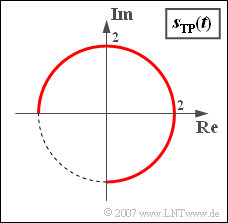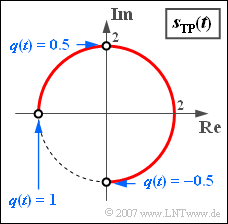Difference between revisions of "Aufgaben:Exercise 4.6Z: Locality Curve for Phase Modulation"
| Line 64: | Line 64: | ||
===Solution=== | ===Solution=== | ||
{{ML-Kopf}} | {{ML-Kopf}} | ||
| − | '''(1)''' The | + | '''(1)''' The locality curve is a circular arc with radius $2$. Therefore, the magnitude function is constant $\underline{a(t) = 2}$. |
| Line 74: | Line 74: | ||
'''(3)''' In general, the relation $s_{\rm TP}(t) = a(t) \cdot {\rm e}^{{\rm j}\hspace{0.05cm}\cdot \hspace{0.05cm} | '''(3)''' In general, the relation $s_{\rm TP}(t) = a(t) \cdot {\rm e}^{{\rm j}\hspace{0.05cm}\cdot \hspace{0.05cm} | ||
| − | \phi(t)} | + | \phi(t)}$ applies here. A comparison with the given function yields: |
:$$\phi(t) = \eta \cdot q(t).$$ | :$$\phi(t) = \eta \cdot q(t).$$ | ||
| − | *The maximum phase value $\phi_{\rm max} = +\pi \; \Rightarrow \; {180^\circ}$ is obtained for the signal amplitude $q_{\rm max} = 1$. From this follows directly ${\eta = \pi} \; \underline{\approx 3. | + | *The maximum phase value $\phi_{\rm max} = +\pi \; \Rightarrow \; {180^\circ}$ is obtained for the signal amplitude $q_{\rm max} = 1$. From this follows directly ${\eta = \pi} \; \underline{\approx 3.1415}$. |
*This modulation index is confirmed by the values $\phi_{\rm min} = -\pi /2$ and $q_{\rm min} = -0.5$ . | *This modulation index is confirmed by the values $\phi_{\rm min} = -\pi /2$ and $q_{\rm min} = -0.5$ . | ||
| − | [[File:P_ID769__Sig_Z_4_6_d_neu.png|right|frame| | + | [[File:P_ID769__Sig_Z_4_6_d_neu.png|right|frame|Locality curve (phase diagram) for a rectangular source signal]] |
'''(4)''' <u>The second and third proposed solutions</u> are correct: | '''(4)''' <u>The second and third proposed solutions</u> are correct: | ||
*If $q(t) = \text{const.} =-0.5$, the phase function is also constant: | *If $q(t) = \text{const.} =-0.5$, the phase function is also constant: | ||
:$$\phi(t) = \eta \cdot q(t) = - {\pi}/{2}\hspace{0.3cm} | :$$\phi(t) = \eta \cdot q(t) = - {\pi}/{2}\hspace{0.3cm} | ||
\Rightarrow \hspace{0.3cm} s_{\rm TP}(t) = - {\rm j} \cdot s_0 = - 2{\rm j}.$$ | \Rightarrow \hspace{0.3cm} s_{\rm TP}(t) = - {\rm j} \cdot s_0 = - 2{\rm j}.$$ | ||
| − | *Thus, for the actual | + | *Thus, for the actual physical signal: |
:$$s(t) = s_0 \cdot {\cos} ( \omega_{\rm T}\hspace{0.05cm} t - | :$$s(t) = s_0 \cdot {\cos} ( \omega_{\rm T}\hspace{0.05cm} t - | ||
{\pi}/{2}) = 2 \cdot {\sin} ( \omega_{\rm T} \hspace{0.05cm} t ).$$ | {\pi}/{2}) = 2 \cdot {\sin} ( \omega_{\rm T} \hspace{0.05cm} t ).$$ | ||
*In contrast, $q(t) = +0.5$ leads to $\phi (t) = \pi /2$ and to $s_{\rm TP}(t) = 2{\rm j}$. | *In contrast, $q(t) = +0.5$ leads to $\phi (t) = \pi /2$ and to $s_{\rm TP}(t) = 2{\rm j}$. | ||
| − | *If $q(t)$ is a rectangular signal that alternates between $+0.5$ and $–0.5$ , then the | + | *If $q(t)$ is a rectangular signal that alternates between $+0.5$ and $–0.5$ , then the locality curve consists of only two points on the imaginary axis, regardless of how long the intervals with $+0.5$ and $–0.5$ last. |
*If, on the other hand, $q(t) = \pm 1$, then the possible phase values $+\pi$ and $-\pi$ result purely formally, but they are identical. | *If, on the other hand, $q(t) = \pm 1$, then the possible phase values $+\pi$ and $-\pi$ result purely formally, but they are identical. | ||
| − | *The | + | *The locality curve then consists of only one point: $s_{\rm TP}(t) = - s_0$ ⇒ the signal $s(t)$ is "minus-cosine" for all times $t$. |
Revision as of 11:52, 12 May 2021
We assume a source signal $q(t)$, which is considered normalised.
- The maximum value of this signal is $q_{\rm max} = 1$ and the minimum signal value is $q_{\rm min} = -0.5$.
- Otherwise nothing is known about $q(t)$.
The modulated signal with phase modulation ⇒ "transmission signal" is:
- $$s(t) = s_0 \cdot {\cos} ( \omega_{\rm T}\hspace{0.05cm} t + \eta \cdot q(t)).$$
Here $\eta$ denotes the so-called "modulation index". Let the constant envelope $s_0$ also be a normalise quantity, which is set to $s_0 = 2$ in the following (see diagram).
If one replaces the cosine function with the complex exponential function, one arrives at the analytical signal
- $$s_{\rm +}(t) = s_0\cdot {\rm e}^{{\rm j}\hspace{0.05cm}\cdot \hspace{0.05cm}( \omega_{\rm T} \hspace{0.05cm}\cdot \hspace{0.05cm} t + \eta \hspace{0.05cm} \cdot \hspace{0.05cm} q(t)) }.$$
From this, one can calculate the equivalent low-pass signal sketched in the graph as follows:
- $$s_{\rm TP}(t) = s_{\rm +}(t) \cdot {\rm e}^{-{\rm j}\hspace{0.05cm} \cdot\hspace{0.05cm} \omega_{\rm T} \hspace{0.05cm}\cdot\hspace{0.05cm} t } = s_0\cdot {\rm e}^{{\rm j}\hspace{0.05cm}\cdot\hspace{0.05cm} \eta \hspace{0.05cm} \cdot \hspace{0.05cm} q(t) }.$$
Hints:
- This exercise belongs to the chapter Equivalent Low-Pass Signal and its Spectral Function.
- You can check your solution with the interactive applet Physical Signal & Equivalent Low-Pass Signal ⇒ "Locality Curve".
Questions
Solution
(2) From the graph it can be seen that the following numerical values apply:
- $\phi_{\rm min} =- \pi /2 \; \Rightarrow \; \underline{-90^\circ}$,
- $\phi_{\rm max} = +\pi \; \Rightarrow \; \underline{+180^\circ}$.
(3) In general, the relation $s_{\rm TP}(t) = a(t) \cdot {\rm e}^{{\rm j}\hspace{0.05cm}\cdot \hspace{0.05cm} \phi(t)}$ applies here. A comparison with the given function yields:
- $$\phi(t) = \eta \cdot q(t).$$
- The maximum phase value $\phi_{\rm max} = +\pi \; \Rightarrow \; {180^\circ}$ is obtained for the signal amplitude $q_{\rm max} = 1$. From this follows directly ${\eta = \pi} \; \underline{\approx 3.1415}$.
- This modulation index is confirmed by the values $\phi_{\rm min} = -\pi /2$ and $q_{\rm min} = -0.5$ .
(4) The second and third proposed solutions are correct:
- If $q(t) = \text{const.} =-0.5$, the phase function is also constant:
- $$\phi(t) = \eta \cdot q(t) = - {\pi}/{2}\hspace{0.3cm} \Rightarrow \hspace{0.3cm} s_{\rm TP}(t) = - {\rm j} \cdot s_0 = - 2{\rm j}.$$
- Thus, for the actual physical signal:
- $$s(t) = s_0 \cdot {\cos} ( \omega_{\rm T}\hspace{0.05cm} t - {\pi}/{2}) = 2 \cdot {\sin} ( \omega_{\rm T} \hspace{0.05cm} t ).$$
- In contrast, $q(t) = +0.5$ leads to $\phi (t) = \pi /2$ and to $s_{\rm TP}(t) = 2{\rm j}$.
- If $q(t)$ is a rectangular signal that alternates between $+0.5$ and $–0.5$ , then the locality curve consists of only two points on the imaginary axis, regardless of how long the intervals with $+0.5$ and $–0.5$ last.
- If, on the other hand, $q(t) = \pm 1$, then the possible phase values $+\pi$ and $-\pi$ result purely formally, but they are identical.
- The locality curve then consists of only one point: $s_{\rm TP}(t) = - s_0$ ⇒ the signal $s(t)$ is "minus-cosine" for all times $t$.

